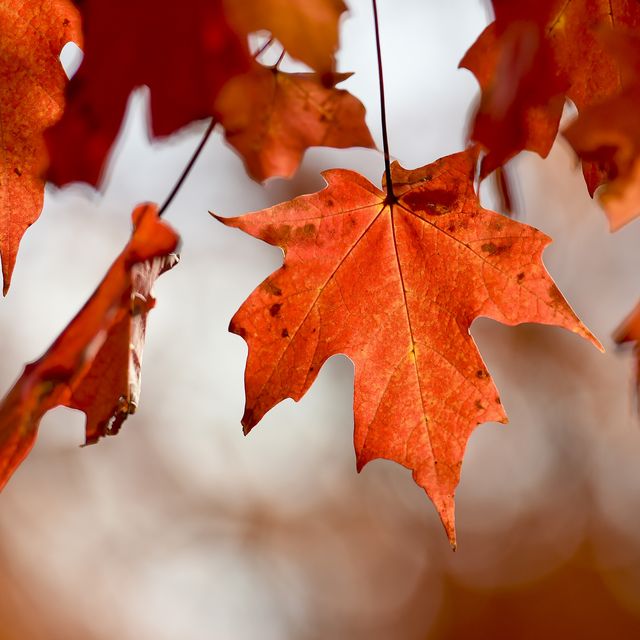- Leaves change color as green chlorophyll subsides and leaves other colors behind.
- Climate change is inducing earlier flowering and earlier fall foliage in deciduous trees.
- “Leaf peeping” is relatively pandemic-proof, and many Americans can do it locally.
Colorful, falling leaves may be the most iconic thing about fall within the temperate zone that experiences all four seasons. In fact, the seasonality and accessibility of “leaf peeping,” or traveling to view fall foliage, has made it big business for decades in New England and other places around the country.
As Appalachian State University explained in 2011:
“In Massachusetts last year, there were 2.5 million fall foliage tourists who spent nearly $2.5 billion dollars ($1,000/visitor). New Hampshire and Maine together attracted over 16 million visitors last year and those tourists spent $2.6 billion dollars. Fall foliage viewing in Michigan accounts for nearly 25 percent of the state’s tourist economy (amounting to nearly $3 billion) and is growing, just like it is in New England.”
But what’s the magic here? Why do leaves change color in the fall?
Let’s Talk About Chlorophyll
There are many types of plants, from the most ancient to more recently evolved species. Trees, alone, are divided into some large major groups, like deciduous and evergreen. Deciduous trees are typically those with broad, flat leaves that change color and fall off annually. Evergreens are those like the fir tree, which have skinny needles that remain year-round and don’t behave the same way on a chemical level.
Leaves are cool. They come in all different shapes and sizes, from the tiniest unfolding fronds of a fern to the largest leaf in the world. That title belongs to the ten-foot-wide leaf that grows on the so-called “corpse flower,” Titan arum, during its nonflowering years. The arum family includes many smaller plants, too, like the pretty anthurium. Titan arum is native to the Indonesian island of Sumatra, where it’s threatened. Thankfully, public interest in the stinky, once-in-a-blue-moon “corpse flower” keeps crowds flocking to local botanical gardens around the world.
Leaves like Titan arum are green because of chlorophyll, the one chemical that’s responsible for the green in every single leaf on every type of plant. During the spring and summer, chlorophyll enables photosynthesis, which is how trees are able to turn sunlight into nutrition and energy. But chlorophyll is triggered by the continuing presence of sunlight, and when the days get shorter, trees “know” to slow down their production of chlorophyll. Why spend energy making a chemical when there’s not enough sunlight to warrant all that production? Winter is coming.
As chlorophyll levels recede, secondary or even tertiary colors come to the surface in the leaves of deciduous trees. These, too, are linked with specific chemicals—just ones that aren’t as vital to energy production. Yellow and orange are carotenoids, and red are anthocyanins. Carotenoids color bananas, corn, daffodils, buttercups, rutabagas, and carrots. Anthocyanins color strawberries, apples, cherries, cranberries, grapes, plums, and blueberries.
How Climate Change Is Affecting Fall Leaves
The change in leaf color is also related to temperature, because trees can sense when the seasons are changing. If the weather gets cold enough early enough in the fall, leaves may fall from the trees even before their color has changed at all. But without anything that extreme, the color of deciduous trees changes starting at higher elevations, working its way down. For long mountain ranges like the Rocky Mountains or the Appalachian Mountains, that means color unrolls over several weeks or longer as it trickles down from higher, cooler altitudes as well as higher, cooler latitudes.
Because tree color is so closely linked with temperature and seasonality, it makes sense that climate change is affecting the season and making its outcomes even more predictable than they already were. One scientist, Stephanie Spera of the University of Richmond, is using people’s personal snapshots from Acadia National Park in Maine to build a long-term study of when and how the leaves changed in that particular area—and how it is changing as a result of climate change. Spera studies climate change via phenology, which is the term for events like fall colors that happen with some kind of regular timing.
Like hiking and camping, leaf peeping is an inherently outdoor activity, which makes it safe even during Covid-19 spikes. People can safely do it outside, and in much of the country, it doesn’t take long to drive to a place with beautiful fall foliage. You don’t even have to get out of the car unless you want to.
In 2011, the biology department at Appalachian State University estimated that 150 million people live within a 10-hour drive of the mountains of North Carolina alone. Destinations like Shenandoah National Park in Virginia offer weekly videos and other updates on the state of the leaves for those who aren’t able to make the trip in person again yet. And there’s always Stephanie Spera’s Acadia project Instagram page.

Caroline Delbert is a writer, avid reader, and contributing editor at Pop Mech. She's also an enthusiast of just about everything. Her favorite topics include nuclear energy, cosmology, math of everyday things, and the philosophy of it all.














